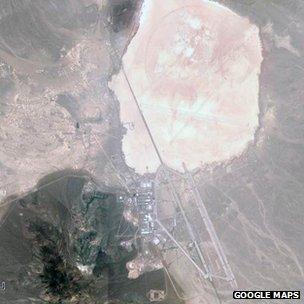Area 51 'declassified' in U-2 spy plane history
- Published
- comments

Area 51, so-named for its designation on a 1950s-era map, surrounds a dry lake bed, Groom Lake
The CIA has officially acknowledged the secret US test site known as Area 51, in a newly unclassified internal history of the U-2 spy plane programme.
The document obtained by a US university describes the 1955 acquisition of the Nevada site for testing of the secret spy plane.
It also explains the site's lingering association with UFOs and aliens.
The remote patch of desert surrounding Groom Lake was chosen because it was adjacent to a nuclear testing facility.
"The U-2 was absolutely top secret," Chris Pocock, a British defence journalist and author of histories of the programme, told the BBC.
"They had to hide everything about it."
The U-2 plane, developed to spy on the Soviet Union during the Cold War, is still flown by the US Air Force.
Reports of UFOs
The document, a secret 1992 internal CIA history of the U-2 programme, was originally declassified in 1998 with heavy redactions.
Many of the blacked-out details were revealed this month after a public records request by the National Security Archive, external at the George Washington University in Washington DC.
The site was selected for the U-2 programme in 1955 after an aerial survey by CIA and Air Force staff.
According to the history, President Dwight Eisenhower personally signed off on the acquisition.
Officials from the CIA, Air Force and Lockheed, the contractor building the U-2, began moving into the facility in July 1955.
While a lengthy account of the development of the U-2 spy plane programme, the history also attempts to shed light on the public's fascination with the Area 51 site and its lingering associations with extra-terrestrials and UFOs.
It notes that testing of the U-2 plane in the 1950s - at altitudes much higher than commercial aeroplanes then flew - provoked "a tremendous increase in reports of unidentified flying objects (UFOs)".
"At this time, no one believed manned flight was possible above 60,000 feet, so no one expected to see an object so high in the sky," note authors Gregory Pedlow and Donald Welzenbach.
'Inclination towards secrecy'
The original request for the redacted portions of the history was made in 2005. It was released to the National Security Archive several weeks ago.
Jeff Richelson, a senior fellow at the National Security Archive, said the long period of secrecy was notable because of the extent people across the world were already aware of Area 51's existence.
Mr Richelson speculates the CIA must have recently made a conscious, deliberate decision to reveal Area 51's existence and origins.
"There is a general inclination towards secrecy," he said, and the many US agencies and non-US governments involved in the U-2 programme would have had a say in the declassification process.
"As far as I can tell, this is the first time something must have gone to a high-enough level to discuss whether or not to formally acknowledge Area 51's existence," he said
- Published25 September 2012